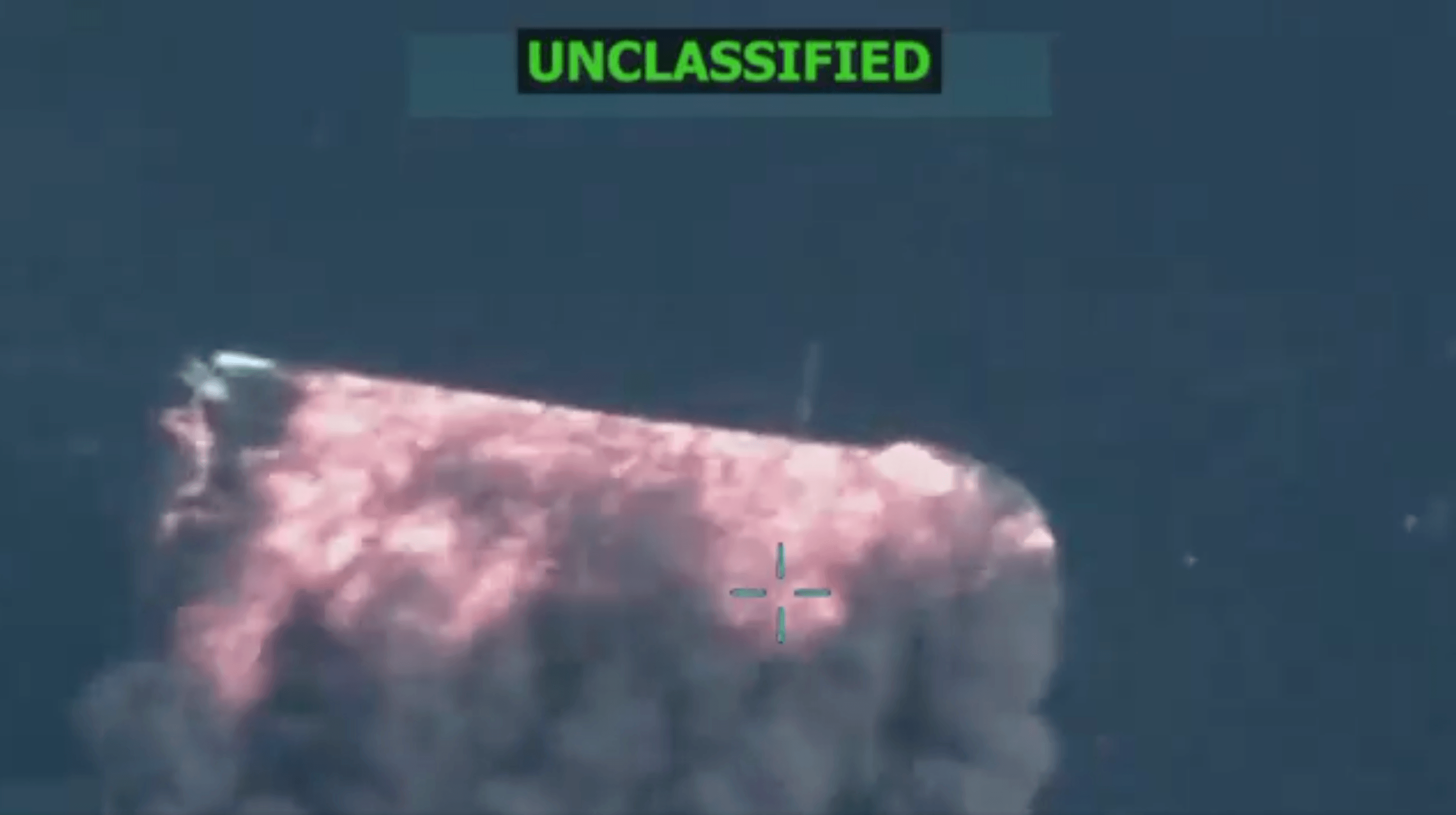What are the Classified Documents in the Trump Indictment?

Published by The Lawfare Institute
in Cooperation With

Editor's Note: The following was originally published on Matt Tait's Substack, PwnAllTheThings.
Donald Trump has been indicted for a second time, but for the first time by the Department of Justice on federal offenses, with charges relating to his mishandling of classified documents, and his subsequent attempts to cover-up that fact from government investigators and the Grand Jury.
The indictment itself is available to read here.
Trump’s valet Waltine (“Walt”) Nauta is also indicted too, presumably with a view to persuading him to cooperate as a witness against Mr. Trump.
Note that this indictment only covers alleged crimes that happened within the jurisdiction of the Southern District of Florida (in other words, at Mar-a-lago). The Office of Special Counsel may bring additional charges in D.C. or in New Jersey (for the Bedminster search) if it believes there are prosecutable crimes committed in those jurisdictions. It can also add or remove additional charges in Florida at a later date too via superseding indictments.
Like all indictments, this indictment includes some mandatory redactions (names of countries and individuals not charged), as well as listing 31 specific classified documents obliquely. We can do a bit of digging to de-anonymize or reasonably guess the contents of some of those.
The Charges
31 counts of Wilful Retention of National Defense Information — 18 USC 793(e)
Conspiracy to Obstruct Justice — 18 USC 1512(k)
Withholding a Document or Record — 18 USC 1512 (b)(2)(A), and abetting
Corrupting concealing a Document or Record — 18 USC 1512[c](1), and abetting
Concealing a Document in a Federal Investigation — 18 USC 1519, and abetting
Scheme to Conceal — 18 USC 1001(a)(1), and abetting
False Statements and Representations — 18 USC 1001(a)(2), and abetting
The first group (wilful retention) relate to the actual holding and retention of specific classified documents. The final group of charges all relate to Trump’s conspiracy to hide them from government investigators and the Grand Jury during the investigation generally.
The Documents (Overview)
The indictment first covers classified documents retrieved by the National Archives (NARA), and which are not the basis of these charges. These are:
15 boxes provided by Trump to NARA in January 2022. These contained 197 classified documents: 98 at SECRET; 30 at TOP SECRET; the remainder at Confidential. Some additionally had Sensitive Compartmented Information (SCI) and Special Access Program (SAP) markings.
During the FBI search of Mar-a-Lago Club, a further 102 documents, recovered from Trump’s office and a storage room. These included 17 documents at TOP SECRET; 54 at SECRET; 31 at CONFIDENTIAL. Of these, Trump’s office held 6 at TOP SECRET; 18 at SECRET; and 3 at CONFIDENTIAL.
The indictment does not seek to charge possession of all of these documents. Only 31 documents are specifically mentioned for the purposes of the charges; one charge per document—to allow the government to take or withdraw each document in the trial separately. The case will therefore center on these documents and not the others.
The named documents are not provided in full, but are described in the indictment. They are:
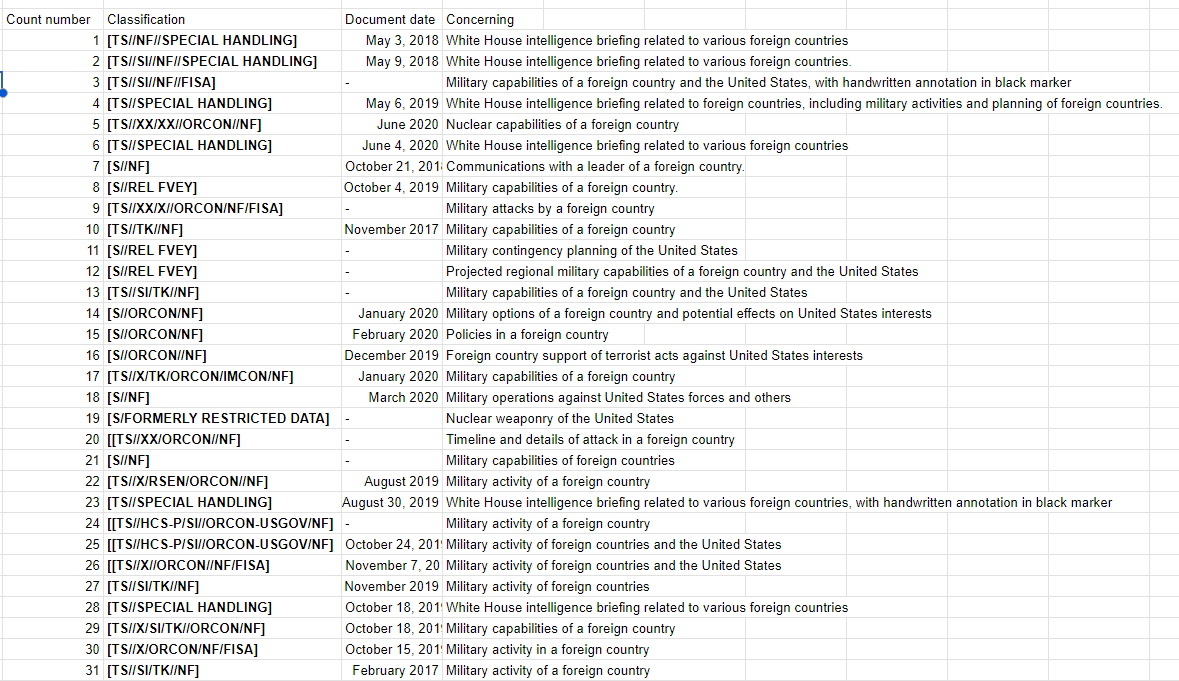
For those with screen readers the text is given below:
[TS//NF//SPECIAL HANDLING] Document dated May 3, 2018, concerning White House intelligence briefing related to various foreign countries
[TS//SI//NF//SPECIAL HANDLING] Document dated May 9, 2018, concerning White House intelligence briefing related to various foreign countries.
[TS//SI//NF//FISA] Undated document concerning military capabilities of a foreign country and the United States, with handwritten annotation in black marker
[TS//SPECIAL HANDLING] Document dated May 6, 2019, concerning White House intelligence briefing related to foreign countries, including military activities and planning of foreign countries.
[TS//XX/XX//ORCON//NF] Document dated June 2020, concerning nuclear capabilities of a foreign country
[TS//SPECIAL HANDLING] Document dated June 4, 2020, concerning White House intelligence briefing related to various foreign countries
[S//NF] Document dated October 21, 2018, concerning communications with a leader of a foreign country.
[S//REL FVEY]Document dated October 4, 2019, concerning military capabilities of a foreign country.
[TS//XX/X//ORCON/NF/FISA] Undated document concerning military attacks by a foreign country
[TS//TK//NF] Document dated November 2017, concerning military capabilities of a foreign country
[S//REL FVEY]Undated document concerning military contingency planning of the United States
[S//REL FVEY] Paged of undated document concerning projected regional military capabilities of a foreign country and the United States
[TS//SI/TK//NF] Undated document concerning military capabilities of a foreign country and the United States
[S//ORCON/NF] Document dated January 2020, concerning military options of a foreign country and potential effects on United States interests
[S//ORCON/NF] Document dated February 2020 concerning policies in a foreign country
[S//ORCON//NF] Document dated December 2019, concerning foreign country support of terrorist acts against United States interests
[TS//X/TK/ORCON/IMCON/NF] Document dated January 2020 concerning military capabilities of a foreign country
[S//NF] Document dated March 2020 concerning military operations against United States forces and others
[S/FRD] Undated document concerning nuclear weaponry of the United States
[[TS//XX/ORCON//NF] Undated document concerning timeline and details of attack in a foreign country
[S//NF] Undated document concerning military capabilities of foreign countries
[TS//X/RSEN/ORCON//NF] Document dated August 2019, concerning military activity of a foreign country
[TS//SPECIAL HANDLING] Document dated August 30, 2019, concerning White House intelligence briefing related to various foreign countries, with handwritten annotation in black marker
[[TS//HCS-P/SI//ORCON-USGOV/NF] Undated document concerning military activity of a foreign country
[[TS//HCS-P/SI//ORCON-USGOV/NF] Document dated October 24, 2019, concerning military activity of foreign countries and the United States
[[TS//X//ORCON//NF/FISA] Document dated November 7, 2019, concerning military activity of foreign countries and the United States
[TS//SI/TK//NF] Document dated November 2019, concerning military activity of foreign countries
[TS//SPECIAL HANDLING] Document dated October 18, 2019, concerning White House intelligence briefing related to various foreign countries
[TS//X/SI/TK//ORCON/NF]Document dated October 18, 2019, concerning military capabilities of a foreign country
[TS//X/ORCON/NF/FISA] Document dated October 15, 2019, concerning military activity in a foreign country
[TS//SI/TK//NF] Document dated February 2017, concerning military activity of a foreign country
Classification guide/Key:
TS: TOP SECRET
S: SECRET
NF: NOFORN - for distribution within the United States only, and not to foreign governments
REL FVEY - information relating to and shared with FIVE EYES partners; namely the United Kingdom, Canada, Australia, and New Zealand.
TK - TALENT KEYHOLE, a compartment that merged from TALENT (imagery product from sensitive manned overflight) and KEYHOLE (imagery from satellite). The combined compartment covers overhead imagery. The existence of the compartment is now unclassified.
SI — Special Intelligence; generally collected signals intelligence and communications intelligence.
FISA — Information relating to, or collected under the Foreign Intelligence Surveillance Act, and which carries additional handling sensitivity because of it.
ORCON — Originator Controlled - a handling caveat specifying that the originator (or originating agency) must be consulted prior to further sharing and/or release of the document.
HCS-P — HUMINT (Human-source derived intelligence) Control System (Product). Used to mark analysis and intelligence reporting whose ultimate information providence includes covert human sources.
X — used here to denote a compartment that is redacted in the document.
FRD — Formerly Restricted Data. A classification category for nuclear secrets under the Atomic Energy Act. See Document #19 section below.
Document #19: US Nuclear Capability
[S/FRD] Undated document concerning nuclear weaponry of the United States
Ordinarily, classified documents fall within the purview of the Executive Branch to classify or declassify. You may, for example, have heard that the President can declassify any document. This is usually true, because most classifications inside the US government track their authority back to the President’s Article II powers as Commander in Chief (or Foreign Affairs), and in both cases are regulated by Executive Order 13526 and its predecessors. Classification crimes are proscribed by statute (as National Defense Information), but usually the definition of National Defense Information will lean on the Executive Branch’s definitions, as defined in the Executive Order.
Not so with nuclear documents. Classification of these documents is by statute, not by EO 13526 or its predecessors. Specifically, these are classified directly via the Atomic Energy Act.
In this group, document #19 is special. This is Formerly Restricted Data, and is classified by virtue of the Atomic Energy Act (as implemented by 10 CFR part 1045). Trump could not have declassified this document even while president—at least not directly. It is National Defense Information by statute, not by executive order.
By statute, documents are classified under the Atomic Energy Act if the Department of Energy and Department of Defense agree that the document (or category) falls within the categories laid out in the Atomic Energy Act. If DOE and DOD disagree, the President can break the tie (in either direction). This means the President could in principle force documents to be declassified by directing the relevant Secretaries to declassify the documents (and firing them if they don’t comply). But critically: the process must occur for the document to be declassified. It is not “at will” declassification by the President.
This is a really big deal, not just because of what it contains, but because it resolves a nasty question about classification EOs and the extent to which they bind upwards as well as downwards in the executive branch heirarchy. Here, document 19 side-steps the question. This document is classified by statute.
Be careful with the term formerly restricted data here. It does not mean the information is no longer national defense information; it means that it can, for the most part, be treated like normal classified information. From a slide at DOE:
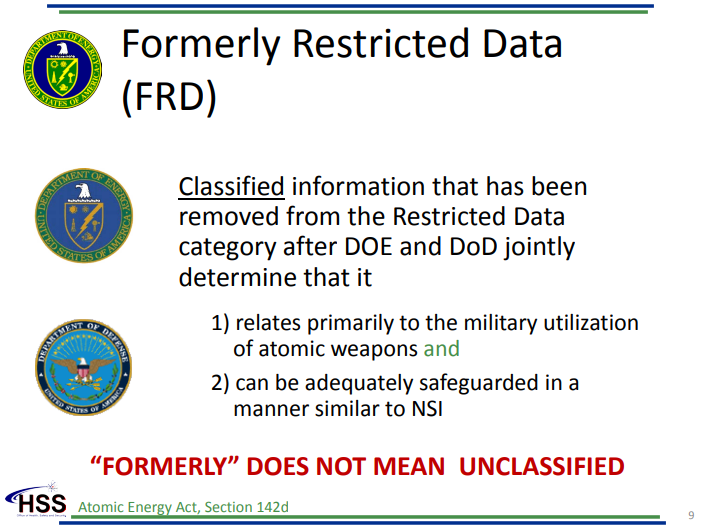
It is not clear what, exactly, the document contains. But a few canonical examples of Formerly Restricted Data include US stockpile quantities, nuclear weapons safety and storage, nuclear weapon yields, and locations of US nuclear weapons.
By contrast, at that level it would not contain information about nuclear weapon design, nuclear material production, reactor design, or use of special nuclear material in the production of energy, which is, by statute, held at the higher RESTRICTED DATA designation.
Note that RD and FRD run in parallel to the “traditional” classification system. Documents can (and often are) both NSI-classified and F/RD-classified. For example, a TSRD document is both TOP SECRET NSI-classified within the meaning of EO13526 and Restricted Data within the meaning of the Atomic Energy Act.
This particular document is classified at both SECRET and FRD.
Document #5 Nuclear capabilities of a foreign country (probably Russia)
[TS//XX/XX//ORCON//NF] Document dated June 2020, concerning nuclear capabilities of a foreign country.
The indictment doesn’t list the country. I think this is probably Russia.
On June 2, 2020, the Russian Federation published for the first time its nuclear deterrence policy, which was previously classified. The Russian nuclear deterrence doctrine is called “Basic Principles of State Policy of the Russian Federation on Nuclear Deterrence.”
Russia changing its nuclear deterrence posture will have certainly featured in the President’s Daily Brief in June 2020.
Document #2: PDB after the Iran Deal
[TS//SI//NF//SPECIAL HANDLING] Document dated May 9, 2018, concerning White House intelligence briefing related to various foreign countries.
This is almost certainly excerpts taken from a Presidential Daily Brief (PDB).
It is a little hard to parse which specific issues the President was interested in from these briefs, other than by analyzing major events that took place contemporaneously which the president was openly interested in.
This PDB is May 9, 2018. This is the day after President Trump made a televised address, withdrawing the United States from the Joint Comprehensive Plan of Action (JCPOA), known colloquially as the “Iran Deal.” The May 9 PDB will certainly have prominently featured international response to this withdrawal.
Document #14: Military options of a foreign country (probably Iran)
[S//ORCON/NF] Document dated January 2020, concerning military options of a foreign country and potential effects on United States interests
I think this is related to Iran in the aftermath of Operation Martyr Soleimani.
On 8 January 2020 (local time, 7 January US time), Iran’s IRGC launched 12 ballistic missiles at the Ayn al-Asad airbase in western Iraq and at the airbase in Erbil, in response to the earlier assassination by the United States of Iran’s Major General Qasem Soleimani in a drone strike.
Although the United States did not retaliate militarily to the strikes (it did respond with several rounds of sanctions), this was a period of very high tensions with Iran, and the United States would quite likely have produced various kinetic option responses for the President in January 2020, as well as requested intelligence community assistance to report on potential effects on United States interests if those options were taken.
Document #16: Foreign government support of terrorist acts against the United States (probably Saudi/AQAP after Pensacola)
[S//ORCON//NF] Document dated December 2019, concerning foreign country support of terrorist acts against United States interests
My guess is that this refers to Saudi Arabia and Al Qaeda in the Arabian Peninsula (AQAP).
In late November 2019 through end of December 2019, there were a few substantial terrorist attacks:
29 November 2019: The Mass-stabbing attack in London by Usman Khan, wearing a false explosive belt which killed 3 and injured a further 3.
6 December 2019: Naval Air Station Pensacola shooting, by a Saudi student.
10 December 2019 Jersey city shooting at a kosher grocery store, with anti-semitic and anti-police motives.
11 December 2019: 2019 Bagram Airfield attack. Taliban militants attacked the main US base, killing 3 and injuring 80.
To be clear: this document could have been in response to any one of these, or none of them. It could also be in response to a foiled terrorist attack.
Of these, President Trump took significant personal interest in both the London stabbing attack, and the Pensacola shooting attack. Of these, the Pensacola attack has a clear foreign terrorist organization behind it (AQAP) and the shooter’s nationality was both politically significant and factored into President Trump’s tweets on the day, as well as the call he took from King Salman of Saudi Arabia; hence, my guess.
Document #7: Communications with a foreign leader (probably INF withdrawal)
[S//NF] Document dated October 21, 2018, concerning communications with a leader of a foreign country.
This could be a lot of things. The previous administration didn’t take care to ensure that communications with foreign leaders were properly documented or relayed to the public, and there is no call sheet for it.
There’s two main candidates here based on what was happening at the time. The first is communication with Saudi Arabia about the murder of Jamal Khashoggi, who was killed on the 2 October 2018. Although this was several days earlier, the Saudi Foreign Ministry reported on October 20 that Khashoggi died at the consulate after being engaged in a fight; the first Saudi acknowledgement of Khashoggi’s death. On October 20, Trump publicly stated he found this claim “credible” and that he had talked two days earlier to the ailing King Salman. It is possible that Trump spoke to either King Salman or Crown Prince Mohammed bin Salman and retained a memorialized copy of the conversation.
I don’t particularly like this theory, though. Trump famously spoke a lot by phone, but not by text. It’s a bit hard to see how that call would have been memorialized, and given Trump’s communication with Salman two days earlier, it would have been perhaps a bit much to expect an additional call three days later on it. And Trump didn’t reference any explicit new communication with the Saudis on October 21. The classification marking is also higher than it should be for such a call.
A better option is probably a communication with the Russian President. On October 21, 2018, Trump announced that the US would withdraw from the 1987 Intermediate-range Nuclear Forces Treaty (INF), which banned ground-launch nuclear missiles with ranges from 500-5500 km.
These documents, which are notionally addressed president to president, will certainly have been memorialized in writing, and would plausibly be described in the indictment as “communications with a leader of a foreign country.” The classification looks about right for that type of exchange of letters too.
Document #18: Military operations against US Forces (probably Hezbollah)
[S//NF] Document dated March 2020 concerning military operations against United States forces and others
This is probably relating to the 2020 Camp Taji attacks between 11-14 March 2020 targeting Camp Taji near Baghdad, which killed two Americans and one British soldier. The US and UK launched air raids against Hezbollah in response.
Document #4: PDB, military activities and planning of foreign countries (probably Iran)
[TS//SPECIAL HANDLING] Document dated May 6, 2019, concerning White House intelligence briefing related to foreign countries, including military activities and planning of foreign countries.
Again, could be a lot of things, but it's probably related to Iranian direct and proxy threats against American forces in the region, and the US’s deployment of the USS Abraham Lincoln carrier and a bomber task force to threaten Iran in response.
[S//REL FVEY]Undated document concerning military contingency planning of the United States
This is probably the “Milley” plan to attack Iran.
Earlier in the indictment (before the charges), DOJ references a conversation transcript in which Trump shows a plan by a “Senior Miltary Official” about a plan to attack “Country A.” The transcript, as given in the indictment, is shown below:
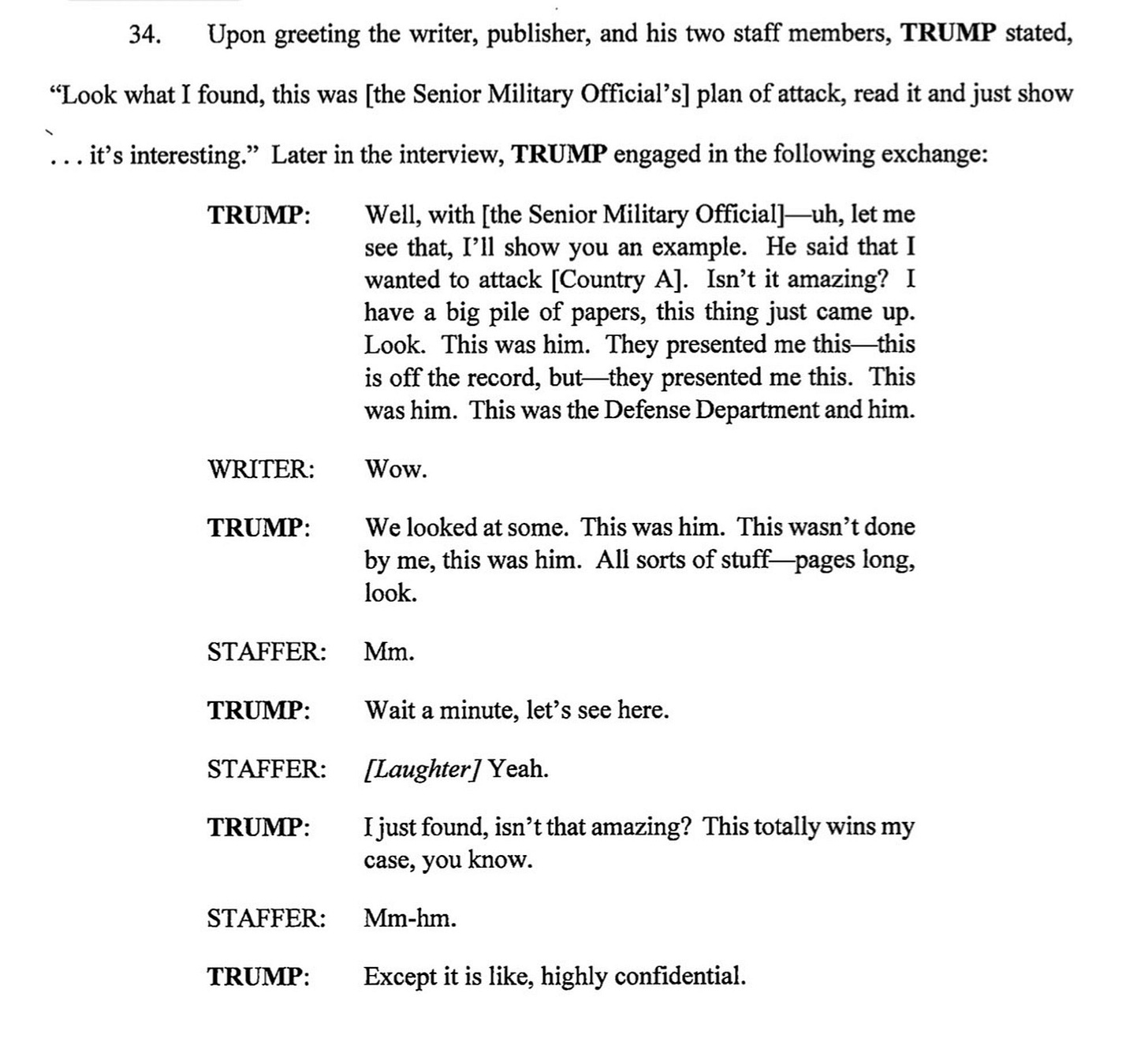
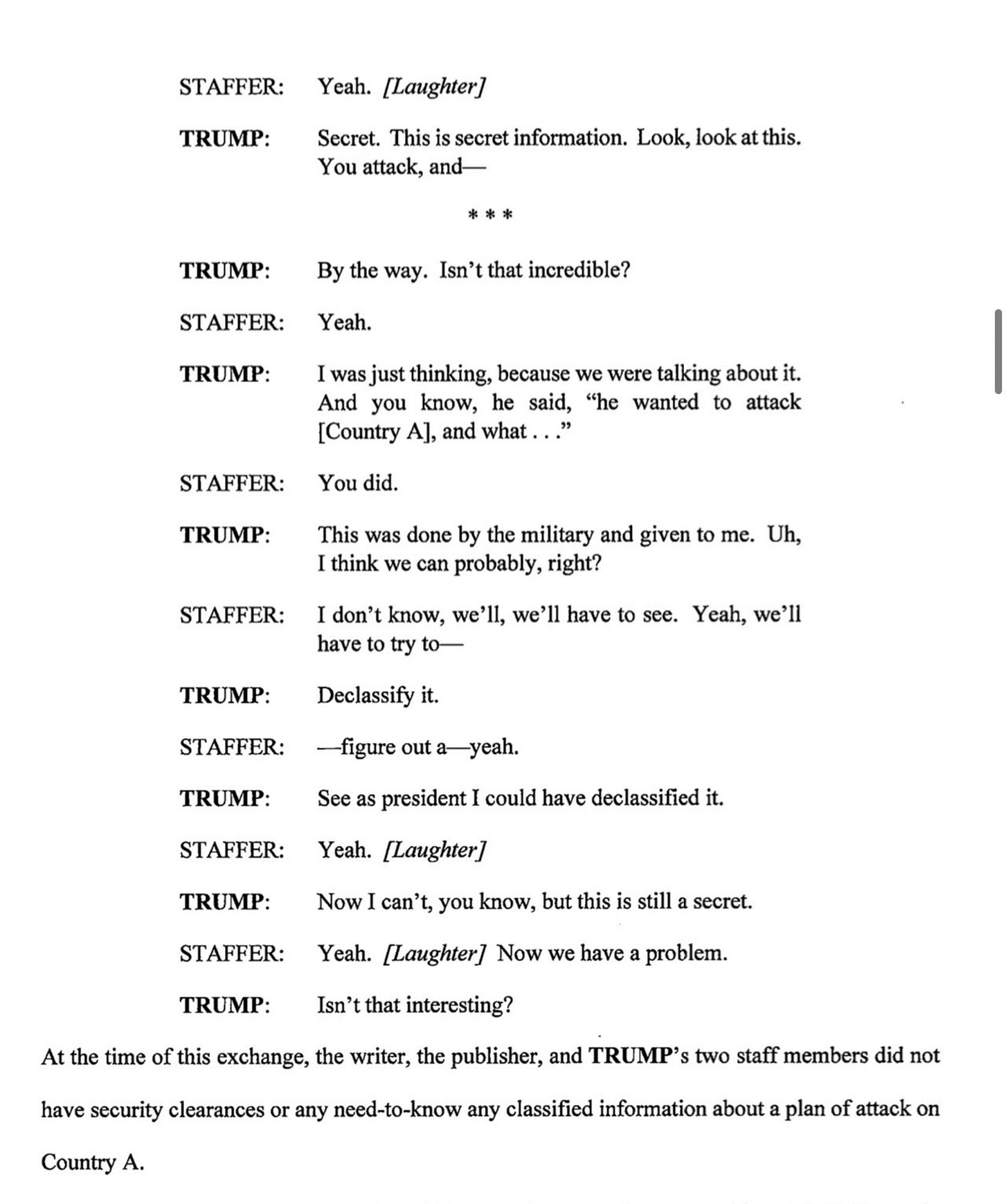
This transcript comes from a tape recording of Trump, which reveals the Senior Military Official as Chairman of the Joint Chiefs General Milley, and Country A as Iran.
We also separately know that this plan was presented to Trump on January 3, 2021, just days before he left office, thanks to an interview that almost certainly has Milley himself as a source.
This leaves a bit of a conundrum: if this conversation is in the transcript, is the corresponding document on the charge sheet? It would be unusual for it not to be so, since the entire point of including the transcript is to show Trump showing off documents he did not have lawful access to, and undermining legal defenses he might otherwise try and employ. Here he freely admits that he knows the document is classified, that the person he is showing to is not cleared to see it, and that Trump did not declassify it while he was President.
Nevertheless, for the transcript to be useful evidence, the special counsel would need to show not just that Trump thought the document is classified, but that it really is. Which would mean it is probably in the list. It doesn’t have to be on the list. But since the point of the transcript here is to show wilful violation by Mr Trump, and the structure of the indictment lists each document as a separate charge, it makes much more sense for one of the charged documents to be this one.
If it is on the list, there’s not many options for it because of the date: it would have to be an undated entry. Of these, document #11 fits the bill nicely.
Of course, I could be wrong here. It could be unrelated. But it makes the most sense given the information we have.
Documents #28, #29, #30: Probably related to the Turkish offensive into north-eastern Syria
#28: [TS//SPECIAL HANDLING] Document dated October 18, 2019, concerning White House intelligence briefing related to various foreign countries
#29: [TS//X/SI/TK//ORCON/NF]Document dated October 18, 2019, concerning military capabilities of a foreign country
#30: [TS//X/ORCON/NF/FISA] Document dated October 15, 2019, concerning military activity in a foreign country
These three documents cover events over the three day period October 15-18, 2019.
The first of these (#28), based on the handling requirements, is probably a direct excerpt from a PDB. The second (#29) is probably a map or satellite graphic, based on the compartment.
These three documents happen about the time of the 2019 Turkish offensive into north-eastern Syria. A close timeline of these events is here.
Specifically, on 14 October 2019, President Trump announced that all U.S. personnel would withdraw from Syria, except those at Al-Tanf base. The PDB the day after (15th) would likely include intelligence community reporting, not just from Turkey and inside Syria, but also other interested parties to the conflict, about their reaction to the withdrawal.
A few days later, on 17 October 2019, Vice President Mike Pence and Turkish President Erdogan reached a deal to implement a 120-hour cease-fire, ending Turkey’s operation in norther Syria. The President would likely have been briefed the day after with maps and other analysis about the state of the ceasefire, and the IC’s analysis about reactions to the ceasefire, whether it will hold, and the state of forces on the ground.
Document #6: PDB (maybe related to barring Chinese flights to the US)
[TS//SPECIAL HANDLING] Document dated June 4, 2020, concerning White House intelligence briefing related to various foreign countries
This is most likely a PDB or extract from a PDB, based on the classification marking here, but it’s a bit unusual. The big international event here is from the day before: June 3, when the Trump administration announced a ban on all commercial passenger flights by Chinese carriers, to begin on June 16.
Although this event has been largely re-cast in recent years to have been motivated by a desire to prevent the spread of COVID to the United States, the proximate cause of the ban was actually in response to a Civil Aviation Administration of China order in late March which limited Chinese and foreign flights. That order also capped the number of flights by any airline to China beyond the baseline of March 12. With no U.S. airlines actually flying to China on that date, that Chinese order effectively barred all U.S. flights to China. By June, Delta and United had been pushing to resume flights to China, but the Civil Aviation Administration of China order blocked this.
On June 3, the U.S. administration retaliated, barring all direct flights to the United States from China. This PDB is from the day after.
There are a several other things the PDB would have contained, but this would seem to be the most likely extract that Trump was personally interested in retaining.


.jpg?sfvrsn=8253205e_5)

